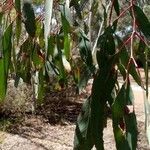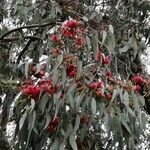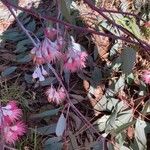Tree to 35 m. Bark hard, black, deeply furrowed throughout or on trunk and larger branches, smooth, white on upper branches. Juvenile leaves alternate, petiolate, linear to lanceolate or ovate, green or grey-green, slightly discolorous. Adult leaves lanceolate to narrowly lanceolate, acuminate or uncinate; lamina green, grey-green or blue-green; lateral veins just visible, at 25°-40°; intramarginal vein up to 2 mm from margin; petiole terete. 10-20 mm long. Peduncle quadrangular to terete; pedicels quadrangular. Buds ovoid, rostrate; operculum conical or rostrate; hypanthium ovoid to hemispherical. Fruits hemispherical, ovoid, subglobular or urceolate; valves 5 or 6, included.
Tree to 35 m with black [jet black or very dark red-black] hard deeply furrowed bark throughout or on trunk and larger branches and white smooth bark on upper branches.. Juvenile leaves linear to lanceolate (or ovate); adult grey, lanceolate, 7–14 cm long, 1.2–1.8 cm wide; petiole terete, 1–2 cm long.. Umbels [3]7-flowered; peduncle quadrangular to terete, [0.5]0.7–2 cm long, pedicels 0.2–1.5[2] cm long.. Operculum 3–5 mm long, 4–5 mm wide.. Calyx-tube 4–6 mm long, 4–5 mm wide.. Fruits ovoid, subglobular or urceolate, 5–11 mm long, 6–10 mm wide with narrow descending disc obscured by broad, caducous staminal ring, and 5 included valves.. Fig. 10/39, p. 49.
Evergreen tree, 15-26 m high, with a moderately spreading crown. Bark persistent, entirely covering main trunk, dark grey to black, hard, corky, non-fibrous, deeply furrowed. Leaves opposite; drooping; blade narrowly ovate to broadly ovate, 60-110 mm long, apex acute, margins entire, greyish green, usually falcate. Flowers: in simple umbels; buds pendulous with conical or beaked lids, up to 12 mm long; stamens exserted; perianth cream-coloured, pink or deep rose-red; May-Oct. Fruit a round to oval capsule, valves deeply included, 8-10 mm long; often covered by a sub-persistent staminal ring.







